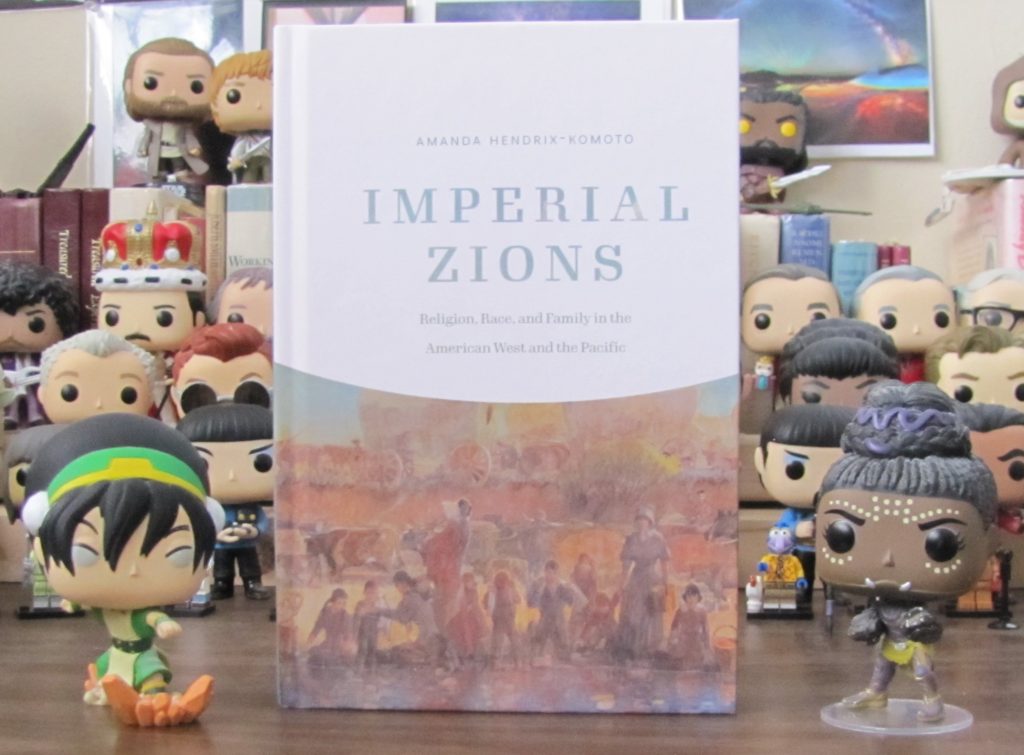Review
——–
Title: Imperial Zions—Religion, Race, and Family in the American West and the Pacific.
Author: Amanda Hendrix-Komoto
Publisher: Lincoln, NE: University of Nebraska Press
Genre: History
Year Published: 2022
Number of Pages: xviii + 260
Binding: Paperback and Hardcover
ISBN-13: 9781496214607
Price: $99.95 (hardcover); 30.00 (paperback)
Reviewed by Samuel Mitchell for the Association for Mormon Letters
Imperial Zions seeks to study the conversion and reception of Indigenous peoples (both in the western United States and throughout the Pacific), as well as to analyze the Mormon practice of polygamy leading up to and during the early Utah period. The studies of gender and race meet in Imperial Zions, and its author, Amanda Hendrix-Komoto, weaves a compelling entry that is both challenging and enlightening.
In terms of content, Imperial Zions is comprised of six chapters, along with an introduction and epilogue that also offer further analysis and commentary on Hendrix-Komoto’s subject material. The Introduction (pp. 1–19) begins with a chilling account of the Bear River Massacre and the fate of the Northwestern Shoshones afterwards. This and other foundational information allow Hendrix-Komoto to then offer a description of early Mormon theology, with an especial focus on the body and Native Americans (“The Race and Sex of God,” 21–46). Chapters 2 (“The Bonds between Sisters,” 47–73) and 4 (“Creating Polygamous Domesticities,” 99–127) focus mainly on the experience of Mormon women during the polygamous eras of Nauvoo and early Utah. Chapters 3 (“Redeeming the Lamanites in Native America and the Pacific,” 75–97), 5 (“Making Native Kin,” 129–154), 6 (155–185), and the Epilogue (187–200) deal in largest part with themes of colonization, racialization, interracial polygamy, and (most especially) the treatment and reception of Indigenous peoples in the broader Mormon story.
I approached Imperial Zions with a certain perspective—namely, that it would dwell largely (if not mostly) on the colonization of the American West and on the interactions of Latter-day Saints with Indigenous peoples and cultures. Thus, I was surprised by the amount of text devoted to the study of early Mormon polygamy, a subject that has been broached in numerous other entries. While I initially wanted more material on numerous Native American tribes (Hendrix-Komoto does a wonderful job analyzing the relationship between the Latter-day Saints and the Northwestern Shoshone, for example), upon further reflection I understand Hendrix-Komoto’s desire to tackle the topic of polygamy. At the heart of Imperial Zions is the notion of relationships—between races and cultures and religions and families. One can hardly consider every single facet of Latter-day Saint internal and external relationships in a single volume, but certainly, the polygamy of late Nauvoo and early Utah is pivotally determinative in how most other Mormon relationships of these periods were constructed. Indeed, one of my favorite parts of Imperial Zions were the narratives (threaded between sections and chapters of the book) that often focused on women like Mary Fielding Smith and their experiences with polygamy.
With all that being said, Imperial Zions nevertheless contains a wealth of information regarding the effects of Mormon religionization and colonization of Indigenous peoples and lands. Important historical background is offered that grounds early Latter-day Saint missionary efforts in the Pacific—not just in terms of Latter-day Saint theology and practices, but also in the broader religious comings and goings in the decades (and even century) leading up to the arrival of Mormon missionaries. Hendrix-Komoto views large, complex stories like this as confidently as she does more intimate accounts that serve as microcosms for broader issues.
Perhaps the most noteworthy of these cases in Imperial Zions is that of the legal battles regarding the legitimacy of Johnny Garr, whose mother was a Shoshone woman and whose father (most likely biologically, but certainly by adoption, as Hendrix-Komoto argues) was a white man (129–154). Johnny was at the very least raised by John T. Garr, who housed Johnny’s widow and children before he himself died in October 1900:
On June 1, 1903, Garr’s siblings used Johnny’s illegitimacy to file a claim alleging that they were ‘sole heirs at law of the deceased’ and that Elizabeth [Johnny’s widow] had nor right to the estate. One of the primary questions in the case was whether Garr had publicly recognized Johnny. … If Elizabeth wanted their children to receive an inheritance, she would have to prove that Garr had claimed her husband (129).
For Hendrix-Komoto, issues of Western ideals of domesticity and Native cultures and the tensions between and within Latter-day Saint boundary-making and assimilation/rejection of Native peoples are all present within the Garr case and throughout Imperial Zions.
Imperial Zions at times surprised, frequently saddened, and most often informed me as I read it. Hendrix-Komoto seeks to highlight both the shortcomings and the ideals of early Latter-day Saints and others as they encountered Native cultures. Imperial Zions is an important contribution to ongoing efforts to center Native cultures, stories, experiences, and perspectives as we seek to further understand the complexities of early Latter-day Saint history and culture.

